My mom and I bought our bedside commode almost two years ago, just before my mom had hip replacement surgery at 89 yrs old. If we had known about them when I was looking after my dad some 30 yrs ago, it would have helped tremendously in the last few months. I have cared for a parent with, and without, a commode, and with one is way easier.
A bedside commode is a portable chair-toilet without running water, which is used as a toilet. There is a bucket beneath the seat which can be removed for cleaning after use. It can be placed in any room, typically by the bed, and is generally used by the elderly or disabled who have trouble getting to the bathroom.
How to use a bedside commode ?
Bedside commodes are remarkably practical, and handy pieces of equipment to have.
In our home, we have used them –
- in the bedroom as a toilet post-hip surgery for my mom
- as an emergency toilet in other rooms
- as a chair when needed where there wasn’t one
- as a raised toilet seat for the last 20 months for my mom
- as a chair on which home care assistants, or I, could wash and give a sponge bath to my mom’s legs and feet
If you have a large enough shower, you can also use them as shower chairs.
You will find bedside commodes which can take the weight of people from zero up to 1500 lb – the models for larger individuals from around 400 lb and up are called bariatric or heavy duty bedside commodes.
Commodes also exist for taller people, and wider models also exist for larger hips.
On almost all models of bedside commode, the height is adjustable, with usually a range of 3- 5 inches of additional height.
And if you don’t like the idea of cleaning up a bedside commode because of the smells and the mess involved with the pale, you can use disposable commode liners, which are simply tied up and thrown out.
What are the different types of bedside commode ?
There are 4 main types of bedside commode and one more specialist type, which all come with different variations.
Static portable bedside commodes
These are very much the standard bedside commode.
They are in the form of a chair with four legs, two fixed armrests, a toilet seat with a lid, and a pale which slots in under the seat for use as a toilet.
The seat and the lid just clip onto the frame, and can be raised up and down.
The commodes are basically a metal frame which has the seat and pale usually made from plastic, as it is easily cleaned.
You can find models to support any weight up to 1500 lb.
There are 4 main types of non-specialty static bedside commodes, which –
- very basic folding models which fold up like a folding chair, and have just the one function as a bedside commode
- there are stacking models which don’t fold up, and which have two functions – as a bedside commode and as a raised toilet seat (if they have adjustable height legs)
- there are also static shower/ bath bedside commodes which can be used as a bath or shower chair, and as a bedside commode
- and lastly there is the 3 in 1, or All in One, bedside commode which can function as a bedside commode, as a safety frame for a toilet, and as a raised toilet seat<
The 3 in 1 commode is probably what most people imagine when they think of a bedside commode.
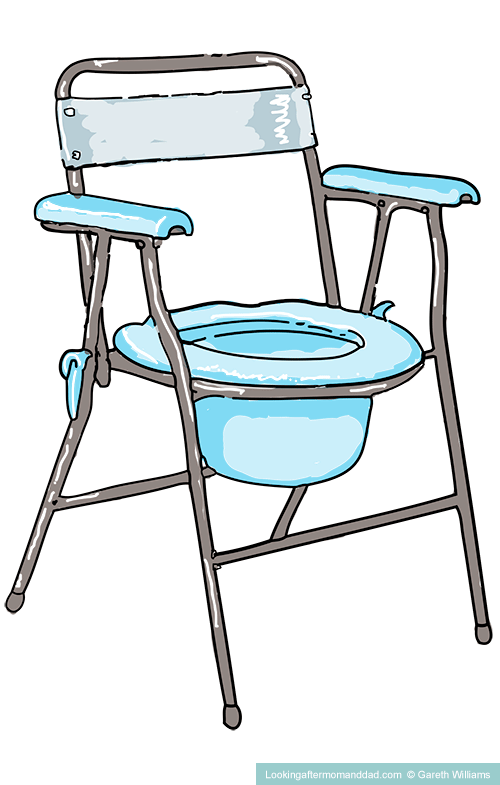
Static folding bedside commode
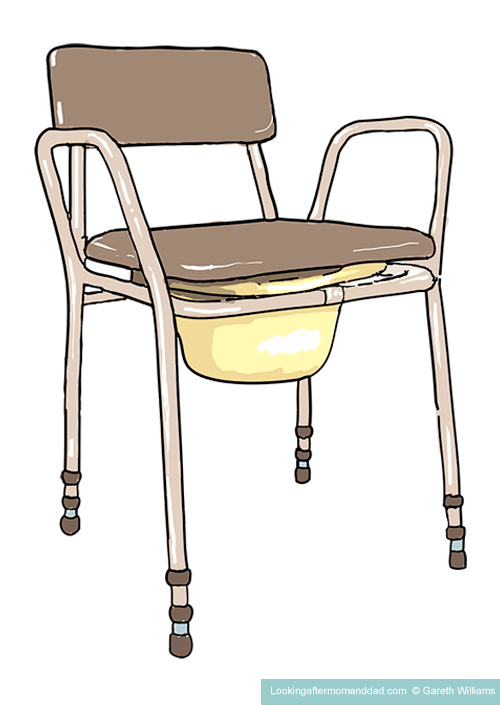
Static stacking bedside commode
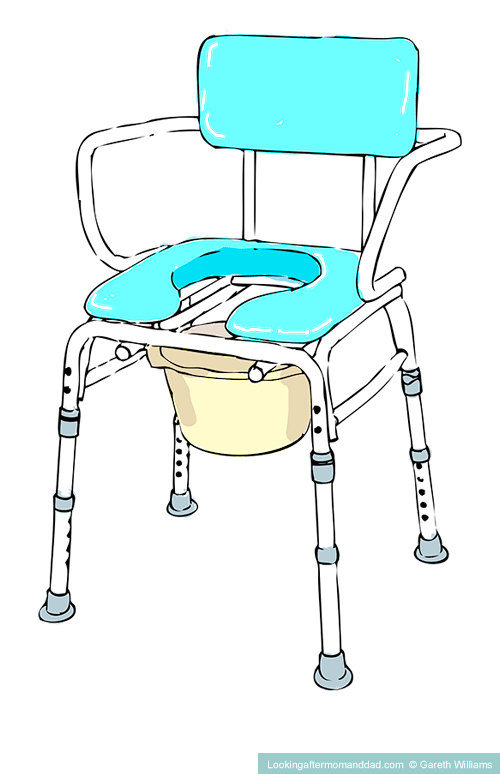
Static shower bedside commode
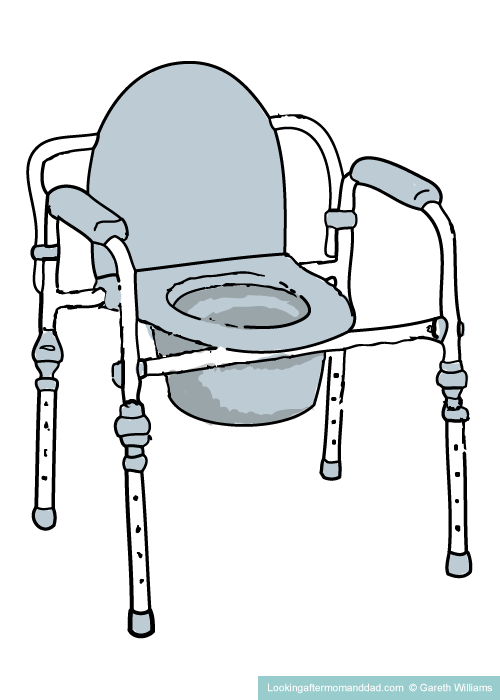
3 in 1 bedside commode
Drop arm bedside commodes
The difference between these and the standard bedside commode is that the armrests are not fixed in place and can be moved either up, down, or often be completely removed.
Some models only have a drop arm on one side, so be aware of that.
Primarily drop arms are designed for people to gain access from the side of the commode, so that they may be able to slide over, into or out from the commode, if they are on a bed, or a wheelchair.
The drop arm also allows caregivers to gain access to a loved one from the side without an armrest being in the way, which can be particularly help with wiping and standing, if the person needs help with that from the side.
Just like the fixed arm bedside commodes, static drop arm bedside commodes may be used as, bedside commodes, raised toilet seats and toilet safety frames.
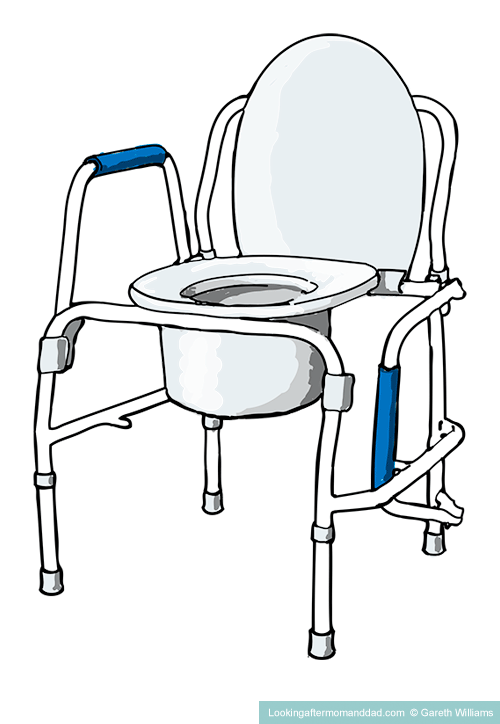
Static drop arm bedside commode
Transport or rolling bedside commodes
Transport, or rolling, bedside commodes are bedside commodes with casters or rubber wheels, and which can be used to transport loved ones around the home when they are unable to walk.
Due to the fact that they have casters, or in the case of self-propelled modes, a wheelchair wheel, these models do not have a weight tolerance which is equivalent to that of the models without wheels.
One of the advantages of this type of bedside commode is that if your loved one is using it because they can’t walk that well, but has control and is not incontinent, then with enough warning, you can remove the commode pale, and then transport your loved one to the bathroom, position them over the toilet using the wheels, lock them in place and give your loved one their privacy until they need you again.
This both gives your loved one some privacy, keeps the odors in the bathroom, and requires no cleaning !!!
Do pick your model of transport commode carefully, to make sure that you are getting one which can be used over a toilet and that has the adjustable height legs required to position over your toilet bowl.
Most models with the highest weight capacity can take up to 600 lb.
Again, if you want to know about which bedside commodes have which weight limits, you can either read my article on bariatric commode weight limits where I list 60 examples here.
Or you can read my article on the weight limits of all bedside commodes, where I list over 140 bedside commodes with their manufacturer’s model number and their maximum weight capacity, here.
Transport, or rolling, commodes can be used for multiple functions, like the other commodes – as a raised toilet seat (if you get the right models), as a bedside commode, and as a transport chair.
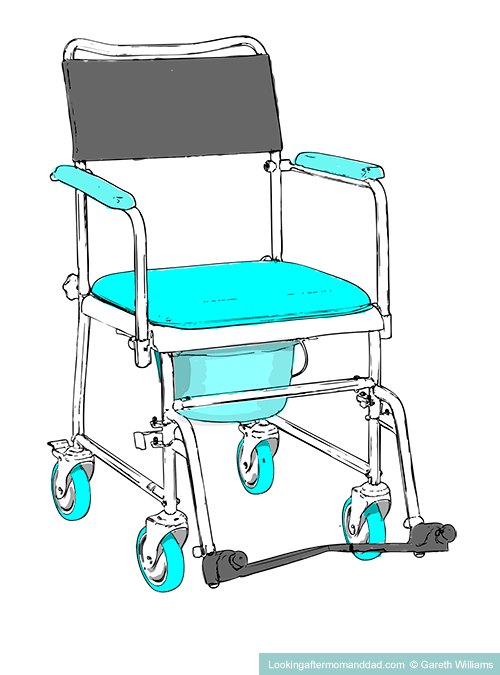
Attendant transport bedside commode
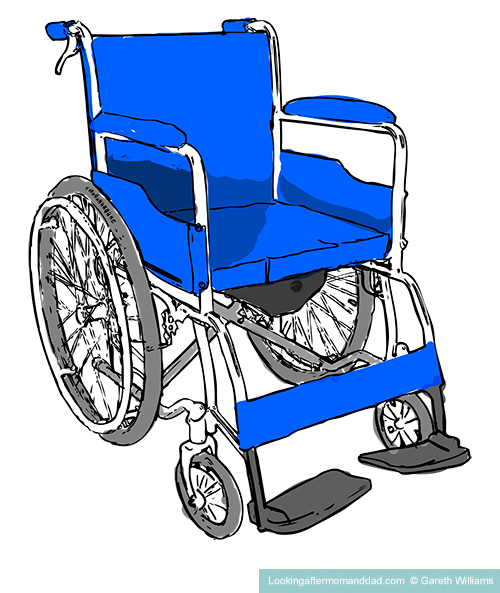
Self-propelling transport commode
Shower/transport bedside commode combinations
These are waterproof shower and transport bedside commodes which have been designed to go into the shower.
Of course, if your shower has a lip or a step, then it will not be able to roll into it !
Just like the other types of bedside commode, it has the usual multiple functions.
It can be uses as a shower chair, transport commode, bedside commode, and provided you don’t buy a model with fixed height and any horizontal bars which will obstruct it, it can be used as a raised toilet seat.
As with the transport models, you need to check when you buy one that it can be used over a toilet.
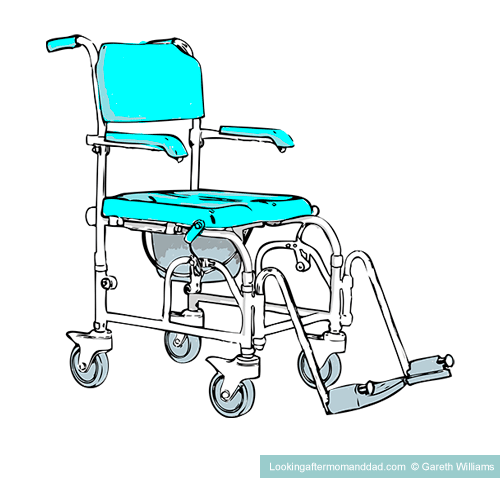
Attendant shower transport bedside commode with four small wheels

Attendant shower transport bedside commode with medium sized rear wheels
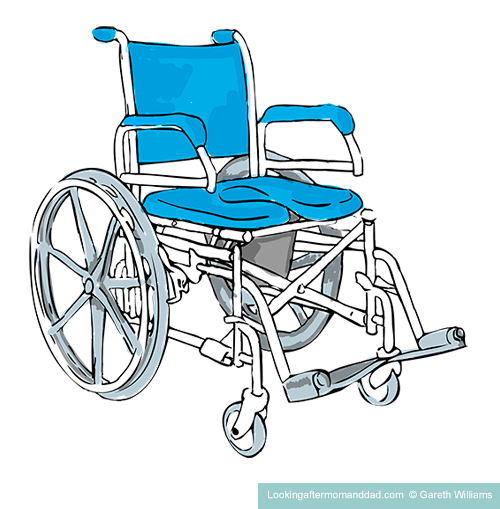
Self-propelling shower transport bedside commode
Transfer bench commodes
The transfer bench commode is a very particular type of beside commode – it is a combined bath, or shower, transfer bench and a bedside commode.
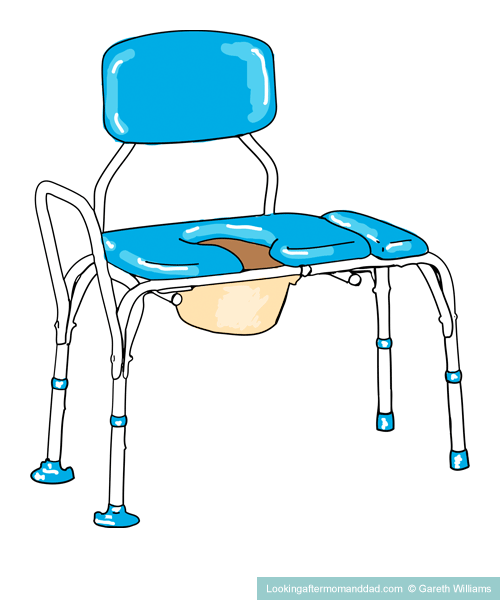
Transfer bench bedside commode
What other variations are there of bedside commodes, and why ?
All the various types of bedside commodes come with different “bells and whistles”, some may be padded, some folding, some extra tall, some extra wide, or with seat differences.
The seat difference is an important one – if your loved one likes to clean themselves, there are seats with an opening at the front designed to allow some independence.
But, in the case of elderly ladies, this may not be a great idea as they need to wipe from front to back to avoid UTI’s.
Bedside commode materials
Bedside commodes can come in a variety of materials, as well as having the other variations –
- some are in aluminum, especially the models for lighter weight individuals
- some are in steel for some bariatric models
- some are in a special PVC which is often used for individuals with compromised immune systems.
While you are looking for bedside commodes, there is lots more that you can do to make your bathroom a safer place for seniors, or anyone else with mobility issues.
To find out all the different things you can do, to have an instant impact on bathroom safety, take a look here, “54 Bathroom Safety Tips For Seniors – A Helpful Guide”.
How to set up a commode chair ?
Static bedside commodes which come flat packed will set up on depending on how they are folded.
If they fold like an ordinary folding chair, you will simply –
- hold the back rest in one hand, and push the seat down with the other hand, and it will take the form of a standing chair
- clip on the plastic seat and the seat lid
- put the seat and lid in the upright position
- set the legs to the height that you require by pushing in the spring-loaded buttons on the legs – make sure they are all the same length, and that buttons lock properly and making a clicking sound – don’t be afraid to test it with a bit of weight before you ask your elderly loved one to use it
- take the commode pale and slot it into the holder under the seat
- if you are using a disposable commode liner, place that over the pale and push it down in, and add any absorbency pads you are using
- if you are not using a liner, you would do well to place about 3 inches of water into the commode pale before you place it into the holder, as this will cut down on odors and make cleaning and tipping out easier after use
- put the seat and lid down over the seat area, and the commode
If your commode comes in a manner which is not folded like a standard folding chair –
- place the folded frame so that the leg bottoms are on the floor with the frame is upright
- pull the front legs away from the back legs and swing them out to 90 degrees from the back of the commode
- take the horizontal bar which is resting against the back legs of the commode and swing it upwards to the level of where the seat will be
- click the horizontal bar into the seat level joints on the front legs
- now continue with the assembly as described above
If the commode frame has come assembled, you just need to –
- place disposable liners in the pale if you are using them
- don’t forget the absorbent pads in the liner if you are using one
- place the pale in its holder
- clip on the seat and lid to the bar which has the pale holder attached to it
- adjust the height of the legs as desired using the spring-loaded push buttons
- make sure the buttons pop out fully – they will make a clicking sound
- make sure the legs are all the same height to avoid accidents
- place the commode where you wish to use it
- if you are not using disposable liners, you will want to now pour about 3 inches of water into the commode bucket to help with odor control and cleaning
Bedside commode transfer
If you are assisting a loved one with sitting on a bedside commode from a standing position, you need first to have them standing with their back to the commode.
First help your loved one to stand.
You may find that if your loved one is very unsteady and has balance and mobility issues, that using a walker is very helpful and increases safety throughout the process.
With my mom we have a walker by her bed which she will often use to help her stand, particularly at night as she is very stiff when she wakes from her sleep if she has been lying there for any length of time.
A walker will give anyone who has difficulty with standing, or backing up to the commode, more confidence in doing so, as they have added stability from the frame, and it will also do so when your loved one has to reach back for the frame armrests.
To sit on the bedside commode, your loved one should –
- with the aid of a walker, back up to the bedside commode moving the walker after each set of steps
- halt the process when they feel the frame of the commode touching the back of their legs
- lower any clothing before they attempt to sit – if you are assisting, it may help if you do this if they lack flexibility
- reach back and take hold of the armrests, one arm at a time – keeping a hold of the walker when the first arm goes back to take an armrest, and then releasing it to take a hold of the other commode armrest
- sit down on the commode when they have the armrests firmly in their grip on both sides
You should not be leaving your loved one to do this on their own if they are not able to do it smoothly and with confidence.
Your loved one should not be falling back on to the seat of the commode, but should be able to lower themselves smoothly onto the seat.
How to keep a commode from tipping ?
To stop a bedside commode from tipping, there are really only a few solutions.
1) You can learn to sit down correctly onto a bedside commode in a controlled manner, as I have laid out in the previous section
2) The commode chair can be wedged into a confined space without wiggle or tipping room –
- in the corner of the room against the walls and some furniture
- or between the bed and the corner of the room
- lastly, do remove any clutter that could cause your loved one to trip
3) There is a commode chair – the Derby Corner Commode Chair – which is built so that the user’s back is facing the corner, and it is virtually impossible to tip this over.
4) Do not let elderly parents who cannot sit down properly on the commode on their own do so without assistance. Get some form of bed alarm to signal you when they need help.
If you wish to know about bed alarms, I have a very in depth article which outlines all the different types of pressure mats, bed pads and remote sensing alarms, which all ring pagers to let you know that your loved one is getting out of bed. You can read that here.
Can a bedside commode be used over a toilet ?
Bedside commodes are also a very good option as a raised toilet seat, as I have already said.
In particular for frail elderly loved ones, in my opinion they are, along with raised seats with safety frames, the most secure form of raised toilet seat.
They have good solid armrests, the weight is distributed over the four legs, they can’t tip off the toilet, and they are height adjustable in the majority of cases, all of which make them a very safe option for the elderly as a raised toilet seat.
With my elderly mom we tried some different raised toilet seats which slotted onto, and also clamped onto, the toilet before her hip replacement surgery, but nothing was a solid as the bedside commode positioned over the toilet.
Do remember, though, that the transport and shower transport commodes don’t always come with adjustable height legs, and some have designs which have horizontal bars at a low level on the back legs which won’t allow for positioning over the toilet.
Some folding static bedside commodes of the simplest kind also won’t fit over a toilet, so always ask the seller if they can be used over a toilet.
Setting a commode up over a toilet –
- start by taking the pale out of the commode
- next check the height that the legs need to be to go over the toilet rim and see if that is good for your commode, and if it is a height that you like – you can always go higher if your commode will, but you obviously can’t go lower
- you push in the spring-loaded buttons on the legs, and either pull the leg down to lengthen it, or push it up to shorten it – make sure that the buttons have popped out with a good click and jiggle the legs around to make sure everything is locked in place as it should be
- all the legs must be the same height
- your loved one’s feet must not be hanging in the air when they are seated on the commode, it can cause accidents when they try to stand, as they can slip
- if you have the legs to a good height, you now put the toilet seat and lid on the bathroom toilet in the upright position
- place your commode over the toilet
- if your seat and lid on the commode are down you can lift them and put in the commode splash guard, if you are using it, in the holder under the seat of the commode
- the splash guard slots in where the pale normally goes
- now put down the commode chair seat, and it is ready to be used
- you do not have to use the splash guard if you don’t want to
- My mom has never used it, and we have never had any problems, and I am the cleaner !
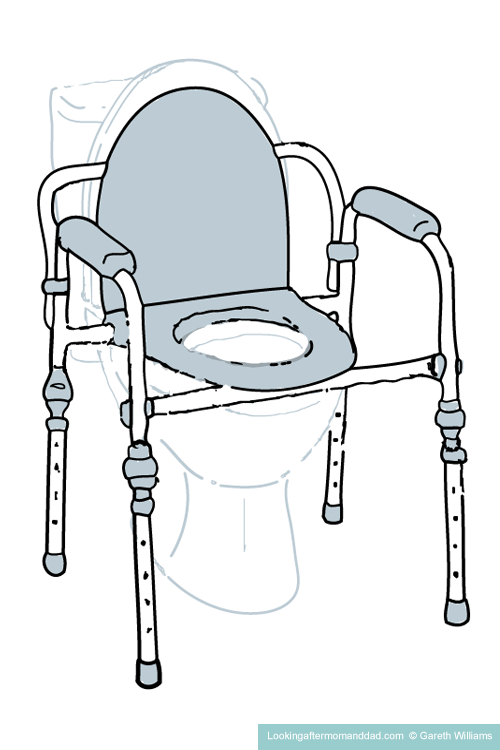
Bedside commode installed over a toilet
Bedside commode odor control
The main point with odor control, and this applies whether you are using disposable commode liners, is that you must empty the commode as soon as possible after its use.
The longer a commode sits full of urine and feces, the longer the smells have to penetrate surfaces and to be absorbed into the surrounding materials.
Consider an extractor fan
If you can afford it, have a workman put in an extractor fan (just like the fans in bathrooms) in the wall just above the bedside commode, which you can easily turn on and off.
This will remove the majority of smells and is much better for the health of the person in the room.
This may seem a bit extravagant in the beginning, but in the long run you will not regret it.
Spraying the softer materials
It helps to spray the soft and fabric furnishings around the bedside commode with disinfectant sprays to kill the odors which are being absorbed into them – this includes mattresses, curtains, cushions etc.
When you use Lysol, OdoBan or Dettol sprays you don’t need to wipe down, and they will kill the bacteria causing the odors.
With Lysol, you need to vacate the room completely for 45 minutes afterwards as the spray has to dissipate in the air, and is not meant to be breathed in, and could be harmful to anyone’s lungs, let alone an elderly adult.
It’s always a good idea to open a window where possible.
If you are not using disposable liners
For those of you who don’t like the idea of using disposable liners, and prefer to tip the pale contents down the toilet –
- put 3 inches of water in the commode pale before use to make cleaning much easier
- add Poo Pourri or another scented oil into the 3″ of water as it forms a barrier on the water surface preventing the odors from escaping, as well as having a covering scent
- always place the lid on the commode pale once it has been used
- empty the commode pale immediately after use
- always have the commode pale covered as you carry it to the bathroom, so the smell isn’t spread down hallways etc. en route to the bathroom
- it is a good idea to have several commodes pales if possible, even 3 pales would be a good idea because you really want to empty the pale, then clean it, and finally to put it to soak in disinfectant for several hours to kill the bacteria which have been absorbed into the plastic, and which are causing the pale to smell even when cleaned – hence you need pales in the commode while others may be soaking in disinfectant
- if you can find ceramic or enameled metal pales which fit your commode they will not absorb odors like plastic will, and so you won’t have to soak them after cleaning
Doing laundries of bed covers and curtains
If you don’t want to have to be spraying your curtains all the time, you can put them into the laundry a bit more regularly with the bed covers, which will need a more frequent laundry regime as they will be absorbing odors from the commode as well.
A lot of people recommend adding white vinegar to the laundry, as it removes odors.
Trash removal
Each time the commode is in use you want to remove any toilet paper and wipes from the room straight away.
Toilet paper can go down the toilet, but wipes should go into the outside trash which goes to landfill, and not to recycling.
Don’t put them into the trash which stays in the room, as again, the smell will just be absorbed by other materials in the room.
If you do have a stinky trash can give it a clean, disinfect it with bleach, or another disinfectant, and sprinkle some baking soda into the bottom.
Cleaning around the bedside commode
Don’t forget to clean the area under the commode bucket and to keep the adjacent surfaces cleaned and disinfected on a regular basis,
If you can put some plastic down on the area under the commode pale in case you have a spill, you can then just remove it and replace with some fresh covering, rather than having to do a deep clean.
If you do have any spills on carpets which will be very difficult to clean, you could use an enzymatic cleaner like those used to clean up pet messes when they are ill on the carpet.
Anti Icky Poo and Nature’s Miracle are two examples of enzymatic cleaners which you could use on carpets.
Tips for bedside commodes
Preparing yourself for commode pale cleaning !!
Tip # 1
Other products that you can add to the 3″ water in the commode pale before use to scent it, other than Poo Pourri (only if you are not using commode liners) –
- lavender essential oil
- peppermint essential oil
- Listerine mouthwash
Tip # 2
For those of you who struggle, with what are not pleasant odors, while cleaning the commode pale, you may want to try wearing a dust type mask with just a small amount of scent, or essential oil on it, and to help to cover the smells.
Oils used by people on a lot of the caregiver forums –
- oil of clove
- oil of lavender
- peppermint oil
- vanilla essence
Tip # 3
Other caregivers instead of a mask will smear on a mustache of –
- vicks
- mentholatum
- horse linament
Tip # 4
Some caregivers prefer to suck strong mints or menthol sweets and hold them high in their palette and drawing their breath up over the sweet to cover the other smells.
Disposable commode liners
Tip # 5
If you don’t want to deal with cleaning the commode pail, you can buy and use disposable commodes liners with absorbent pads.
The pads will absorb all the liquids, and all that is then required is to tie the liner up, seal it, and to put it in the outside trash.
Tip # 6
If you don’t use an absorbent pad or use a liner with a gelling agent, you still have to tip the contents down the toilet and then throw the liner away, but you shouldn’t have to clean the pale.
Tip # 7
Just because you are using a liner does not mean that you are cutting down on the odors in the room, except for the commode pale which won’t absorb the odors.
But if you leave the liner and its contents sitting unattended to in the commode pale, the odor will still spread around the room and be absorbed into the surrounding materials.
So do empty, dispose of them immediately once they have been used.
If you would like to learn more about disposable commode liners, buying them in bulk, the different brands, homemade versions and more, I have put together all I know about them in an article that you can read here.
If you are wondering about how environmentally friendly they are, I have another article “are commode liners recyclable ?” where I look at that question, and what that means in regard to commercial products such as disposable commode liners. You can read that article here.
Cleaning the commode
Tip # 8
Popular and much recommended cleaning products for commodes on forums include-
- Lysol cleaner and disinfectant
- Pine-Sol cleaner and disinfectant
- OdoBan
- Dettol
- Method toilet cleaner
- White Vinegar
Tip # 9
To clean a bedside commode you will want to clean, rinse, disinfect and rinse the commode again. You can use a cleaner and disinfectant combined, but the goal is to first clean away any material which is on the commode, and then to disinfect it once that is done.
Tip # 10
It is best to start by removing the seat, the lid, the pail and the armrests, and cleaning those first before the frame.
Tip # 11
For all the plastic surfaces, don’t forget whatever cleaners and disinfectants you use they must be non-abrasive, otherwise they will degrade the surfaces and make it easier for bacteria to get into the plastic.
Tip # 12
To reduce the amount of skin infections that your loved one can get, you need to make sure that the areas where their skin has the most contact are thoroughly cleaned – the armrests and the seat.
Tip # 13
The areas with the most material stuck to them will be the underside of the seat, the pale, the splash guard (if it is used) and bits of the frame around these areas, so give them a good soak with water a few times before cleaning to soften anything up which is stuck to the surfaces.
Maintenance
Tip # 14
Regularly go over the commode and check the plastic of the seat for any cracks, which can lead to splitting and accidents.
All parts with cracks should be replaced.
Tip # 15
Make sure that there is no rust in any of the joints and that the spring-loaded push buttons are always locked in place and don’t need replacing.
Tip # 16
Keep an eye on the condition of the ferrules – the rubber tips of the legs – for splitting.
If they split, they need to be replaced.
You can easily find and buy replacement “ferrules” online.
I’m Gareth, the author and owner of Looking After Mom and Dad.com
I have been a caregiver for over 10 yrs and share all my tips here.

